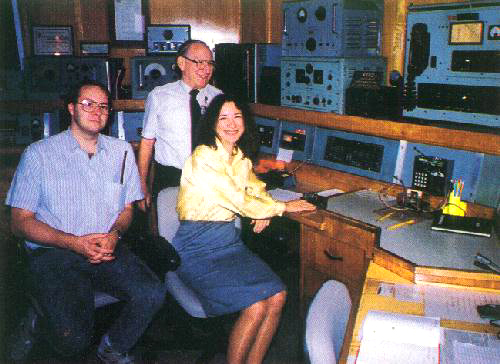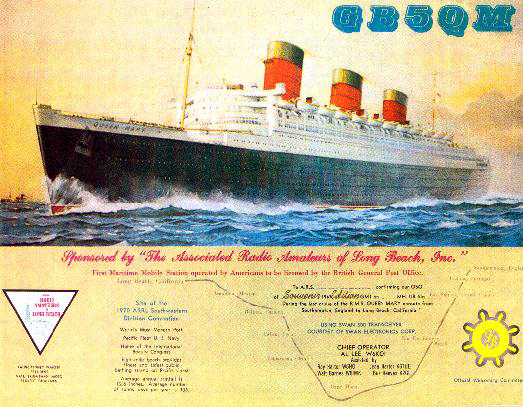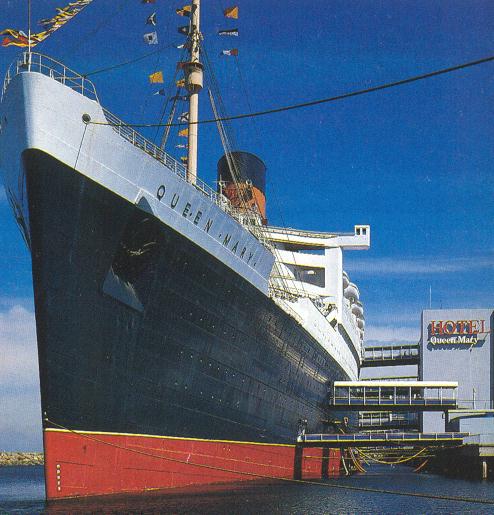THE 40 DAYS OF GB5QM/MM
by Al Lee, W6KQI
Sun City, Arizona
The Queen Mary embarked on its ultimate voyage amid worldwide
fanfare and the accompaniment of Amateur Radio.
TO commemorate an historic event, a quarter of a century ago,
a group of hams from southern California took on what may have been one
of the greatest projects ever undertaken by an Amateur Radio club. When
the City of Long Beach, California, purchased the luxury liner the R.M.S..
Queen Mary from the Cunard Lines in 1967, it was decided to allow passengers
on her final cruise from Southampton, England, to Long Beach, California.
Nate Brightman, K60SC, came up with the idea of putting a ham station aboard
the mighty Queen. He convinced the Board of Directors of the Associated
Radio Amateurs of Long Beach (ARALB) to allow him to start the wheels turning
for whatever it would take to set up and operate a special-event station
to publicize the city's purchase of the ship and how it was to be used
as a tourist attraction. I booked passage, as did club members Ray (W6HO)
and Jean (K6TUE) Harter, of Long Beach. Ray agreed to be a station operator,
as did another passenger, Walt Barnes, W6IMK of San Gabriella California.
Following the public announcement of our project, Herb Johnson, W6QKI
of Swan Engineering in Ocean side, graciously provided us with two Swan
500 HF transceivers and other equipment, including a Swantenna mobile antenna
and a special attachment for mounting it on the ship's rail. The ports
of call included Southampton; Lisbon, Portugal; LAs Palmas, Canary Islands;
Rio de Janeiro, Brazil; Valparaiso, Chile; Callao, Peru; Balboa, Canal
Zone; Acapulco, Mexico; and Long Beach, California. The trip was made around
Cape Horn on the southern tip of South America because the ship is too
large for the Panama Canal.
Problems and Solutions
It was touch and go for a while, but with Nate's persistence and
the cooperation of the U.S. State Department, the ARRL, the British
General Post Office (GPO) Communications Department and Cunard Lines, the
issuance of special-event call sign GB5QM was authorized, pending inspection
of our station on board the Queen Mary prior to departure. After an interesting
trip to Southampton via London, I obtained permission to go aboard
before most of the passengers arrived. I met the First Electrician, who
reminded me that the ship's power is 200 volts DC. I asked him if
he could help me obtain 115 volt, 60-Hz AC. He had a husky motor-generator
on wheels in his shop with a 200-V dc motor connected to a generator
that put out 115-V, 60-Hz AC, and he asked me if I'd like to use
it. I was slightly over-whelmed by the question, but expressed my appreciation,
and soon it was installed in a fan room and wired to the cabin we were
to use as a radio room. Soon after going aboard the Queen and trying
to get the gear set up and the antenna installed, I was met on deck
by Eric Godsmark, G5CO, Chief of the Communications Department of the GPO,
and two inspectors. They were right on schedule, but had arrived
less than one hour after I had started to unload the boxes and set up the
station. I apologized for not being ready and Godsmark graciously said
he'd return in the afternoon. The two inspectors offered to stay and help
me with the installation. What a wonderful gesture on their part. They
stated that they had tremendous interest and curiosity in what I was doing
and couldn't believe that hams could own such sophisticated equipment.
Soon Godsmark returned and the station was ready.
 |
| VINTAGE RADIO: What display on the Queen Mary gets more eyes
to sparkle than anything else? The radio room, where interesting sounds
flow from people stop to wander in and ask questions. Some visitors are
just fascinated to look at the radios and daydream about what it might
have been like to communicate by radio from a faraway ocean. What ham wouldn't
enjoy a radio contact from the Queen Mary? That's what OEX Editor Jon Bloom,
KE3Z , and ARRL Educational Activities Department Manager Rosalie White,
WALSTO, got to try their hands at during a shipboard visit with Nate Brightman,
K60SC. The operators on the other end are always excited to find out it's
the Queen Mary they've reached. |
Then the first problem arose: To tune the Swantenna, you start on 3995
kHz and tune the extendible top section for maximum RF, as read on a field
strength meter. To change bands, though, requires 12 V DC, but all I had
were 220 VDC, 115 VAC and 12 VAC. Buchan said, "I have an 18-volt battery
in my walkie-talkie. Let's try that". So out it came and I clipped it into
the circuit and it worked. Now I was on 75 meters, but British hams
can't go above 3800 kHz and the antenna first has to be tuned on 3995.
So, with the head of Great Britain's communications regulatory agency sitting
next to me, I explained the procedure and asked if I might make a brief
transmission on 3995. He seemed to be enjoying the whole thing so much
that he said, "Certainly, go right ahead. " After peaking the antenna on
3995, 1 switched to 20 meters. Meanwhile, as I tested, Buchan needed his
battery back to communicate with the other inspectors on board. They were
looking for RFI to the ship's communications, PA and intercom systems while
I transmitted. Each time I needed to change bands, out came the battery
from his hand-held. I was given a clean bill of health by the inspectors,
and Godsmark stated, "Now, I have the unpleasant duty of asking you for
six pounds ($16.80 US at that time), in exchange for which I will issue
to you this licence, authorizing you and your fellow operators to operate
GB5QM/MM (maritime mobile) and GB5QM/MA (maritime at anchor)" He then endorsed
the 16-page document with "Signed on behalf of Her Majesty's Postmaster
General, C. E. Godsmark." Godsmark declared that I was not only the
"first American ever to be licenced to operate a station on a British vessel,
but it was the first time a VFO was to be used to control a maritime transmitter."
For this reason, he wanted to check the nature and design of the equipment
personally. He then stood up, shook my hand and said, "Cheerio, Mr Lee,
and good luck on your trip." I was so dumbfounded that I forgot to present
a gift package to him on behalf of our club.
Departure Day: October 31, 1967
Sailing from Southampton was a truly moving event. As the tugboats pushed
the giant liner out into the Solent River, the band playing Auld Lang Syne
began to fade. As we got underway with our own power, the Royal Navy flew
a group of helicopters overhead in the formation of an anchor. Even though
it was a regular working day for most everyone on shore, there were more
than 10,000 Britons who came to Southampton to bid the Queen Mary farewell.
All ships sounded their horns and dipped their flags to half mast as we
passed. The following day, I met with the other two operators
and we agreed on a tentative operating schedule. Our fourth operator, Buz
Reeves, K2GL, from Tuxedo Park, New York, made his appearance later.
Buz had brought his own equipment aboard to operate from his cabin on "A"
Deck. The GPO and the ship's communications officer didn't quite
go along with this, so Buz came to my cabin to offer, and was later given
approval by the GPO, to use our call sign, GBSQM, on 10 meters (his logs
were to become our property). His assistance was greatly appreciated, as
he turned out to be a terrific operator. The station was licensed to operate
in England (/MA), on the high seas and later in US territorial waters,
but before arriving at each intermediate port, we had to turn everything
off and become tourists.
Touring the stopovers are stories in themselves. We wanted to operate
the station as much as possible while at sea. We had antenna problems from
the beginning, so the decision was made to make 20- and 15-meter dipoles
from whatever material was available aboard ship. Wire was plentiful, but
when I asked the First Electrician for something to use as a center insulator,
the smallest ones he could offer were 10 inches long! For feed line, there
was a large supply of British 850 ohm TV receiving coax. It went together
easily and with a little pruning we got them to resonate within the bands.
What a time for the band to be dead. Ray called CQ for more than
two hours without an answer.
After dinner, it was back to the shack. This time, 20 meters was open
and the pileup began. For four hours, I worked lots of stations and was
thankful when Walt relieved me at 2330 local. While operating near the
southern part of South America as we approached Cape Horn, I worked Don
Wallace, W6AM, in Palos Verdes, who was using his famous rhombics, and
I contacted Herb Gleed, W6FQ, in Los Angeles, of QCWA Net fame. I apparently
gave Gleed a better report than I did Wallace, which must have excited
him, because Gleed still likes to remind me of this when we have an eyeball
QSO or work each other on the air. Rounding the Horn was a memorable occasion,
but I did more sightseeing than operating until clear of the cape. Band
conditions were good for most of the remainder of the trip. We were frequently
put off the air by the ship's chief communications officer, though, because
we apparently interfered with the ship's communications while they were
handling commercial traffic. It was frustrating, but at least he was polite
about it and we were compelled to cooperate.
 |
| WHAT A QSL: Hams who contacted GB5QM received this impressive
81/2- x 1 1 -inch color certificate commemorating the Queen's final voyage,
courtesy of the ARALB. The color separator who worked on the artwork for
this certificate, Bob Spiegel, became intrigued by the operation and eventually
became a ham himself, WB6ILM. |
Saturday, December 9
We passed San Diego as the final day of the cruise dawned. I talked
with hams along the coast who said the Queen looked quite beautiful against
the rising sun. The seas were rough and the wind was bitter. It was the
first cold weather since crossing the equator. I wished I hadn't packed
away my topcoat and gloves. Our club president, Walt "Mac" McClellan, WB6NQU,
of Bellflower, California, went aeronautical mobile to view the Queen and
take pictures. I worked him part of the time, but calls were coming in
from all over. The pilot was famous aviator Fran Berra, and she had difficulty
finding the ship for a while. I got run off the air again, so I shut down
the station, grabbed my cameras and photographed the reception in Long
Beach. Off Huntington Beach, we were met by hundreds of boats. By the time
we reached Long Beach, there were more than 1000 boats to greet us as we
sailed slowly past Long Beach to Point Furman, then came about to steam
through Angel's Gate. The boats lined up on both sides, but gave us a clear
path to the pier for docking.
By late afternoon, I went ashore, leaving the gear on board, and found
my luggage. I cleared customs in a tent set up especially for the occasion.
Next, I found my family, and Nate and his family, and off we drove. Home
again.
December 10
It was my responsibility to get the gear off the ship and return it
to Swan Engineering in Oceanside. I was able to go aboard and tear down
the station, repack it and remove it from the ship. Before disconnecting
though, I put out a few CQs using the call sign GB5QM/6 and had few responses.
The excitement of working this rare station was over.
Post Mortem
As a result of this special voyage, I met many fine people and established
lasting friendships. We made more than our expected number of contacts
- after all, GB5QM was never advertised as a DX-pedition. For years afterward,
Nate and I visited radio clubs to present our story and slide show. It
was always a pleasure to make these presentations. Nate continues to direct
shipboard operations on the Queen Mary on behalf of the 250 member ARALB,
and established club station W6RO, which operates today. He's ably assisted
by Bill Holder, W6TNB, and by Bob Hennessy, WD6AVW, head of the 10-person
QSL Committee.
R.M.S. QUEEN MARY - Grand
Lady of the Seas
One of the world's legendary superliners, the RMS Queen Mary's
keel was laid in December 1930 by John Brown & Company Ltd at the Clydebank
shipyard in in Scotland. Workers installed more than 600 telephones, 700
clocks, 2000 glass portholes and 5000 chairs, sofas and tables. Named by
Her Majesty Queen Mary at the shipyard on the River Clyde on September
26, 1934, the opulent ship was launched at Southampton, England, although
her official homeport was Liverpool. Her maiden voyage began May 27, 1936,
as she sailed to New York City. In her heyday, she was a massive and impressive
monument to maritime luxury. When placed in service, she was the world's
largest liner. Able to make better than 30 knots, the 81,200 ton three-stacker
was the world's fastest ocean liner until 1952. She measures 1018 feet
from stem to stern with a 119 foot beam, 200 foot foremast, four 35 foot
propellers and two 16 ton bow anchors on 900 feet of chain weighing 45
tons. She draws 39 feet of water and has accommodations for 1957 passengers
to sail in high style, with a crew of 1174. The ship has 12 decks, including
a 724 foot promenade deck, and carried 24 diesel powered lifeboats. Her
luxurious main lounge is three decks high and 96 feet long. The Queen Mary
had the most successful career of all the superships. She made 1000 North
Atlantic crossings and carried two million passengers in 31 years of service.
She earned $600 million for the Cunard-White Star Line.
During WWII, she carried 765,400 military personnel (as many as 15,000
at a time), and 12,800 GI brides and children, logging 569,400 miles through
dangerous wartime seas. As with all British cruisers, the Queen Mary's
communications equipment and radio officers were leased to the shipping
line by the International Marine Radio Company. The ship's call sign, GBTT,
has been reissued to the Queen Elizabeth II. The extensive onboard collection
and display of vintage radio equipment includes a complete spark gap station
and a duplicate of the radio used on the Titanic. John Porter, WA6TNK,
is responsible for the antique wireless exhibit.
 |
| TODAY: The Queen Mary as she appears after her conversion to
a hotel and convention centre. (Queen Mary Promotional photo). |
Operated as a hotel, restaurant museum and tourist attraction
by the City of Long Beach since about 1969, the Queen Mary was taken over
by the Port of Long Beach in 1978, which financed the restoration of the
original wireless room and made accommodations for a ham station. The head
of the Queen Mary Department of the City of Long Beach, John McAdams, became
so interested in the amateur operations that he subsequently became licensed
as KI6AV. The Port leased the ship to the Wrather Corp in 1979, and it
was that year that W6RO went on the air. In 1988, the Wrather lease was
purchased by the Disney Company, which wanted to remove the ham station.
Nate Brightman, K60SC, who had established the ham operation and ensured
that the station would carry a million dollars' worth of ARRL liability
insurance, convinced the Harbor Commissioners to issue a special permit
to authorize the station to continue operating from the Queen Mary indefinitely.
Disney's lease has expired, and at the beginning of 1993 the ship goes
back under the authority of the city of Long Beach, which will select a
new operator. The lively radio room is a highlight of the Queen Mary tour,
and its operators are happy to chat with anyone who stops to look in through
the Dutch doors. If a visitor happens to be a ham, he or she is invited
to sign the guest book and get on the air. Guest ops receive a handsome
certificate. Brightman estimates that more than 2000 hams stop by each
year. To visit the Queen Mary, take the Long Beach 710 Freeway to
the end (south from LA) at Pier J. A nominal fee is charged for adults
and for parking. For information call 310-435-4747. Bring your license.
Via QST Magazine , December 1992
Return to Radio Reading Room


